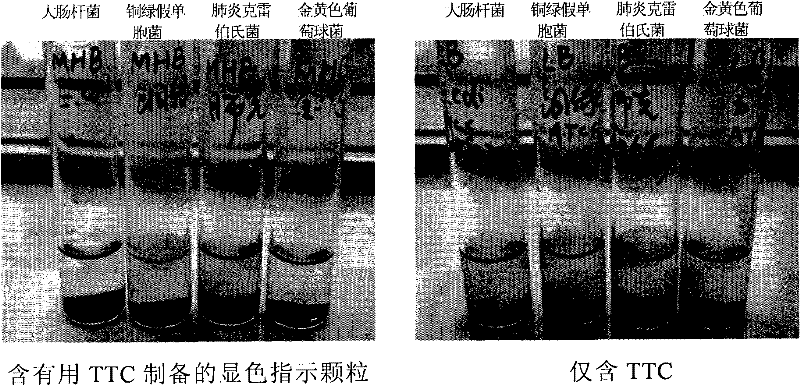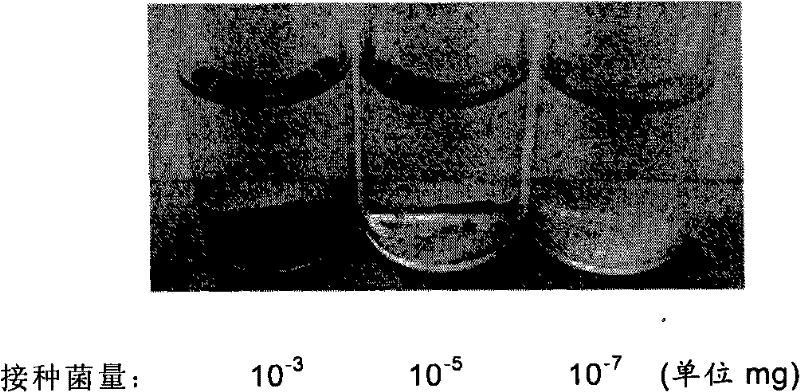A color-developing particle indicating microbial growth and its preparation method
A technology for indicating microorganisms and microorganisms, which is applied in the field of chromogenic particles and preparations indicating the growth of microorganisms, and can solve the problems of being relatively sensitive to temperature, humidity and light, poor indicating effect of positive bacteria, and slow growth of Mycobacterium tuberculosis.
- Summary
- Abstract
- Description
- Claims
- Application Information
AI Technical Summary
Problems solved by technology
Method used
Image
Examples
preparation example Construction
[0059] The present invention also provides a method for preparing particles indicating the growth of microorganisms, the method comprising: mixing a redox indicator (optionally, a substance capable of proton transfer and / or a stabilizer) with the granulate to obtain an adherent Particles with (optionally also attached with a protonically capable substance and / or stabilizer) a redox indicator. The adding method and mixing sequence of the redox indicator, proton-transmitting substance and / or stabilizer are arbitrary, and the present invention has no special limitation.
[0060] The medium in which the oxidation-reduction indicator (optionally also includes proton-transferable substances and / or stabilizers) mixed with the granules can be water or an organic solvent. Described organic solvent is such as methanol, ethanol etc. The amount of water or organic solvent used is the minimum amount to ensure uniform mixing. Increasing the amount of solvent will not affect the effect, but...
specific Embodiment approach
[0063] As a specific embodiment of the present invention, a tetrazolium salt redox indicator is adsorbed on silica gel particles to prepare stable and low-toxic color indicator particles.
[0064]As a preferred embodiment of the present invention, there is provided a specific method for preparing indicator particles indicating microbial growth, including: (1) adding a certain amount of tetrazolium salt (TTC, MTT, INT, TNBT, NBT, One of OTC, NTC, PTC, MTC, etc.) and a certain amount of substances that stabilize tetrazolium salts (boric acid, citric acid or succinic acid) and a certain amount of proton-transferable substances PMS or PES and pre-heated at 130°C After activating for 2 hours, the cooled silica gel particles are mixed evenly and dried in an oven to make color indicator particles, so that tetrazolium salts and the like are adsorbed on the surface of the silica gel particles.
[0065] The color indicator particle can be used as a general reagent. Before inoculation or...
Embodiment 1
[0071] Example 1, preparation of color indicating particles
[0072] 1. Reagent preparation
[0073] (1) Weigh 30 g of 200-mesh silica gel (purchased from Shanghai Shangbang Industrial Co., Ltd.), place it in an oven at 120°C for 2 hours, seal it and cool it down.
[0074] (2) Weigh 40 mg of TTC and dissolve it in 40 ml of distilled water (1 mg / ml), filter it aseptically, aliquot it, and store it in the dark at 4°C.
[0075] (3) Weigh 40 mg of PMS and dissolve it in 40 ml of distilled water (1 mg / ml), filter it aseptically, aliquot it, and store it in the dark at 4°C.
[0076] (4) Prepare 0.1M citric acid solution, aliquot after sterile filtration, and store at 4°C.
[0077] 2. Take 8ml of 0.1M citric acid solution in a sterile environment and add it to 40ml 1mg / ml tetrazolium salt (TTC) solution, then add 0.2ml 1mg / ml PMS, mix and pour into 30g activated silica gel particles, Stir with a sterilized glass rod until uniform.
[0078] 3. Dry the mixture in an oven at 80°C, s...
PUM
 Login to View More
Login to View More Abstract
Description
Claims
Application Information
 Login to View More
Login to View More - R&D
- Intellectual Property
- Life Sciences
- Materials
- Tech Scout
- Unparalleled Data Quality
- Higher Quality Content
- 60% Fewer Hallucinations
Browse by: Latest US Patents, China's latest patents, Technical Efficacy Thesaurus, Application Domain, Technology Topic, Popular Technical Reports.
© 2025 PatSnap. All rights reserved.Legal|Privacy policy|Modern Slavery Act Transparency Statement|Sitemap|About US| Contact US: help@patsnap.com



